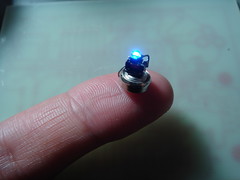Wow, thats a very compact version!
I've built a couple of circuits like these, just to power white/blue LEDs off 1.5 volts. The tricky part is that the inductor is a key component here, and its mechanical and electrical properties determine how well it all works.
There are versions with the bifilar coil as posted in this thread, but its also possible to make this circuit with a singly wound coil with a tap at some point... both work.
Downside of it all is that the output current is hard to predict/calculate and also depends greatly on input voltage. You can use it to power a bluray laser off a single 1.5v cell, but don't go anywhere near the diodes maximum current!




